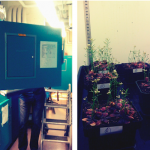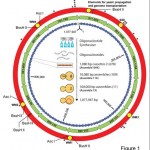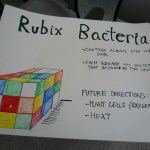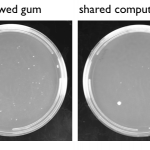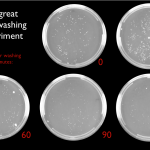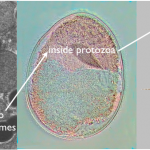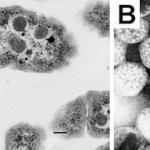bacteria
Check out this awesome video of a computer-controlled swarm of magnetic bacteria building a pyramid out of tiny bricks!!!
From IEEE Spectrum, via It Takes 30, the always fascinating blog from Harvard Systems Biology, the department my lab is in!
Sometimes among all of the tedious protocols and mundane inconclusive data, I forget that I'm doing something amazing and incredibly powerful. Almost all my experiments require altering a living organism to do my bidding--to hold onto and replicate a piece of DNA that I'm interested in or to produce an enzyme that I want a lot of. Thanks to iGEM this summer I've gotten to learn some new soon-to-be-tedious protocols that seem absolutely thrilling now, and the experience is reminding me of how awesome (in the real sense of the word) genetic engineering is.
The team is working with the model…
While poop jokes are all in good fun here in the US (and in other developed parts of the world), diarrhea really isnt all that funny for most of the planet. Dehydration due to diarrhea is the second leading cause of death for babies, worldwide (it was #1 until we started aggressive education/re-hydration efforts). Hundreds of thousands of people die from cholera and enterotoxigenic E. coli (ETEC) infection every year.
Thats not funny :(
So scientists have been working really hard to create vaccines to cholera and ETEC, and a group of folks have figured out a really cool strategy--…
The trailer for Shaun of the Dead.
Not all zombies are created equal. The most popular zombie archetype is a shambling, brain-eating member of the recently deceased, but, in recent films from 28 Days Later to Zombieland, the definition of what a zombie is or isn't has become more complicated. Does a zombie have to be a cannibal corpse, or can a zombie be someone infected with a virus which turns them into a blood-crazed, fast-running monster?
For my own part, I have always preferred the classic George Romero zombies from the original Dawn of the Dead and Day of the Dead films (as well as…
Mark Pendergrast writes: To kick off this book club discussion of Inside the Outbreaks, I thought I would explain briefly how I came to write the book and then suggest some possible topics for discussion.
The origin of the book goes back to an email I got in 2004 from my old high school and college friend, Andy Vernon, who wrote that I should consider writing the history of the EIS. I emailed back to say that I was honored, but what was the EIS? I had never heard of it. I knew Andy worked on tuberculosis at the CDC, but I didn't know that he had been a state-based EIS officer from 1978…
In a recent conversation about the safety and ethics of synthetic biology in the wake of the announcement of the synthetic genome, many of the professors I was chatting with commented on how they hoped new synthetic biology technology would lead to bacteria that could eat the oil spilling into the gulf of mexico even as I type this right now. Of course, the "technology" for oil eating bacteria already exists and have already been used for clean up in previous oil spills--many naturally occurring species of bacteria can already break down the hydrocarbons in crude oil. The natural oil eaters…
Biosafety has been on everyone's mind this week after the announcement of the J. Craig Venter Institute's successful transplantation of a synthetic genome. What horrible pathogen will future bioengineers be able to design? What unforeseeable environmental catastrophe will befall us upon the release of genetically engineered bacteria? These are hugely important questions as research in synthetic biology moves forward, being discussed in congressional hearings and as an integral part of every new synthetic biology design.
As the major proposed goal of a great deal of synthetic biology research…
The J. Craig Venter Institute has just announced the creation of the first bacterial cell controlled by a genome that is entirely chemically synthesized (PDF). The group has been working towards this goal for several years now, first working out how to synthesize and assemble such large pieces of DNA and how to transplant a genome from one organism to another. This result puts it all together, a synthetic version of the genome of the bacterium Mycoplasma mycoides and transplantation into a Mycoplasma capricolum cell. This synthetic cell is almost identical to a natural M. mycoides, but also…
For several years, health professionals have been concerned about the rise in infections from methicillin resistant staphylococcus aureus, or MRSA - a bacteria that's resistant to several of the antibiotics generally used to treat staph infections. CDC estimates that in 2005, there were more than 94,000 MRSA infections in the US, and more than 18,000 of those patients died. The numbers are probably much higher now.
A study just published in the journal Pediatrics gives us new information about staph infections in hospitalized US children and how they're being treated. The results show a…
Are aliens little green men of unpredictable motives? Horrible insect-like face-hugging, chest-exploding monsters? Are they super-smart, super-slimy, super-fishy, body-cavity-probing, disc-flying creatures, searching for planets to colonize and people to destroy as Stephen Hawking warned, or are they something much more mundane? Could there be alien life already on earth, too microscopic, too different to notice? Could life on earth have been seeded from an alien land, with secret messages encoded in our DNA? We've been scanning the sky for extraterrestrial radio signals for years, should we…
I've been co-teaching a short class on synthetic biology this spring through the MIT High School Studies Program (HSSP). The program is awesome, I took classes through a similar MIT program as a nerdy middle schooler and have had a great time teaching the past few weeks (if you're in the Boston area I highly recommend checking it out as a student or as a volunteer teacher!). My students were terrific--smart, open to new and crazy ideas, thoughtful about bioethics issues, and enthusiastic about thinking about what biology can do and designing new biological species.
Today was our last day of…
The past few days I've been learning a lot about the bacteria that surround me and realizing just how labor intensive an actually well-controlled handwashing experiment can be! Here is a little bit more of the data I've collected about bacteria on everyday objects:
Dusty corners (unsurprisingly?) have the most bacteria, followed by chewed gum, then pens and computer mice. These data also show that the medium of bacterial transmission has a huge effect on what shows up on the plate. Leaving the actual object on the plate--in this case a dust bunny--allows for a lot of bacterial transfer, as…
I've been busily rubbing all sorts of things on bacterial growth plates after all the great suggestions I got yesterday. I want to present the data from the first big experiment suggested by JerryM, who wondered what kind of bacteria would be present on my hands immediately after washing them and then every thirty minutes after that until the next washing. My hypothesis was that there would be a small number of colonies on the plate I touched right after washing, and then steadily growing in number over time. I thought this would especially be true considering that I spend most of my time…
Commenter JohnV asked me whether I had let any of my silkworms crawl on an LB plate (what microbiologists use to grow colonies of bacteria) to see what kind of bacteria is living on them in case I ever suffer from catastrophic experiment contamination. I hadn't thought of what kind of bacteria could be living on my silkworms (we are thinking about what kind of bacteria live in their digestive systems that help them digest leaves) so I tried it out! I let one of my wormies crawl on a plate, and I touched one with my relatively clean fingers as a pseudo-control.
I let the plates incubate at 37…
So I had this great post planned about the Boston aquapocalypse but by the time I managed to get some water samples to the lab they had started heavily chlorinating the water and no bacteria were left! Since negative results don't make for good blog posts, please enjoy this video of my silkworms dancing to Flo Rida's Right Round instead.
My two great thesis project loves are hydrogen and symbiosis, and as such, the recent news of a multicellular organism that lives in a completely oxygen free environment and gets its energy from hydrogenosomes instead of mitochondria is totally fascinating.
Hydrogenosomes are organelles that are evolutionarily related to mitochondria. Mitochondria generate energy for the cell by transferring electrons pulled off of sugars molecules to oxygen (this is why we breathe oxygen). The energy from this electron motion is transferred to the production of ATP, the energy currency of the cell, through…
Because of my recent interest in autonomous, biologically inspired robots, my friend Tami sent me some fascinating links about designs and concepts for future flesh eating robots.
From New Scientist, furniture that captures vermin and uses the biomass to power fuel cells that run small electronics:
From Wired, Human corpse powered robots being developed by the Defense Department:
From the file marked "Evidently, many scientists have never seen even one scary sci-fi movie": The Defense Department is funding research into battlefield robots that power themselves by eating human corpses. What…
Neither plane crashes nor anti-aircraft fire could kill my namesake uncle, but MRSA did, and it wasn't pretty. Accordingly I take a particular in this nasty bacteria, and am looking forward to reading Maryn McKenna's new book, Superbug: The Fatal Menace of MRSA, which I just ordered from Amazon, and which comes out next week.
While you're waiting to order yours, you can see hear from McKenna about MRSA, and the new strain's emergence in the daughter of a Dutch pig farmer, in this short video clip:
<object width="425" height="349"><param name="movie" value="http://www.youtube.com/v/…
We all know that as we type on our keyboards or click our mice, we leave behind fingerprints that could be used to deduce our identities. But these prints aren't the only remnants of our presence. Bacteria from our skins also linger on the things we touch and they could act as a sort of living fingerprint.
The thriving community of bacteria and other microscopic passengers on our skin has many traits of interest to a forensic scientist. For a start, they are remarkably personal in their membership and stable over time. Just 13% of the bacteria on my palm also live on yours, and even…
Carboxysomes are small compartments inside photosynthetic bacteria where the machinery for capturing carbon dioxide is concentrated. You can see carboxysomes and their characteristic virus-like shape when you look at slices of these bacteria under an electron microscope:
Until recently, no one had looked at carboxysomes under the microscope in cells that were still alive. My labmates Dave and Bruno developed a way to label carboxysomes with fluorescent proteins and track them under a microscope as the cells grow, and their amazing paper in Science details some of the fascinating systems they…
